2002 MERCEDES-BENZ CLK-CLASS seats
[x] Cancel search: seatsPage 62 of 341
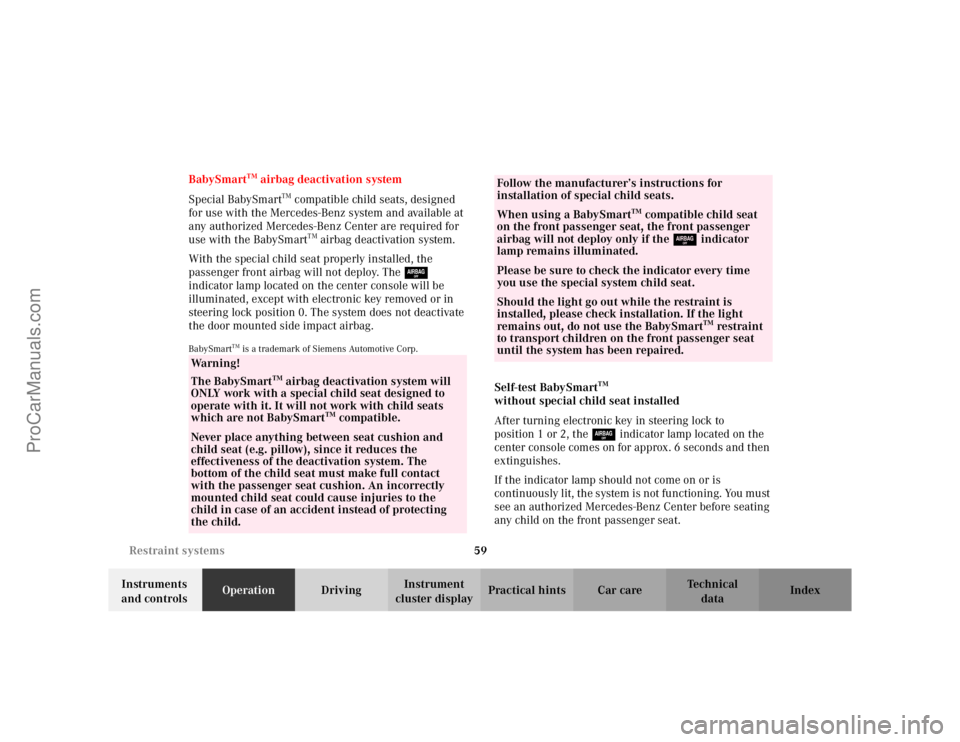
59 Restraint systems
Te ch n i c a l
data Instruments
and controlsOperationDrivingInstrument
cluster displayPractical hints Car care Index BabySmart
TM airbag deactivation system
Special BabySmart
TM compatible child seats, designed
for use with the Mercedes-Benz system and available at
any authorized Mercedes-Benz Center are required for
use with the BabySmart
TM airbag deactivation system.
With the special child seat properly installed, the
passenger front airbag will not deploy. The 7
indicator lamp located on the center console will be
illuminated, except with electronic key removed or in
steering lock position 0. The system does not deactivate
the door mounted side impact airbag.
BabySmart
TM is a trademark of Siemens Automotive Corp.
Self-test BabySmart
TM
without special child seat installed
After turning electronic key in steering lock to
position 1 or 2, the 7 indicator lamp located on the
center console comes on for approx. 6 seconds and then
extinguishes.
If the indicator lamp should not come on or is
continuously lit, the system is not functioning. You must
see an authorized Mercedes-Benz Center before seating
any child on the front passenger seat.
Wa r n i n g !
The BabySmart
TM airbag deactivation system will
ONLY work with a special child seat designed to
operate with it. It will not work with child seats
which are not BabySmart
TM compatible.
Never place anything between seat cushion and
child seat (e.g. pillow), since it reduces the
effectiveness of the deactivation system. The
bottom of the child seat must make full contact
with the passenger seat cushion. An incorrectly
mounted child seat could cause injuries to the
child in case of an accident instead of protecting
the child.
Follow the manufacturer’s instructions for
installation of special child seats.When using a BabySmart
TM compatible child seat
on the front passenger seat, the front passenger
airbag will not deploy only if the 7 indicator
lamp remains illuminated.
Please be sure to check the indicator every time
you use the special system child seat.Should the light go out while the restraint is
installed, please check installation. If the light
remains out, do not use the BabySmart
TM restraint
to transport children on the front passenger seat
until the system has been repaired.
ProCarManuals.com
Page 63 of 341
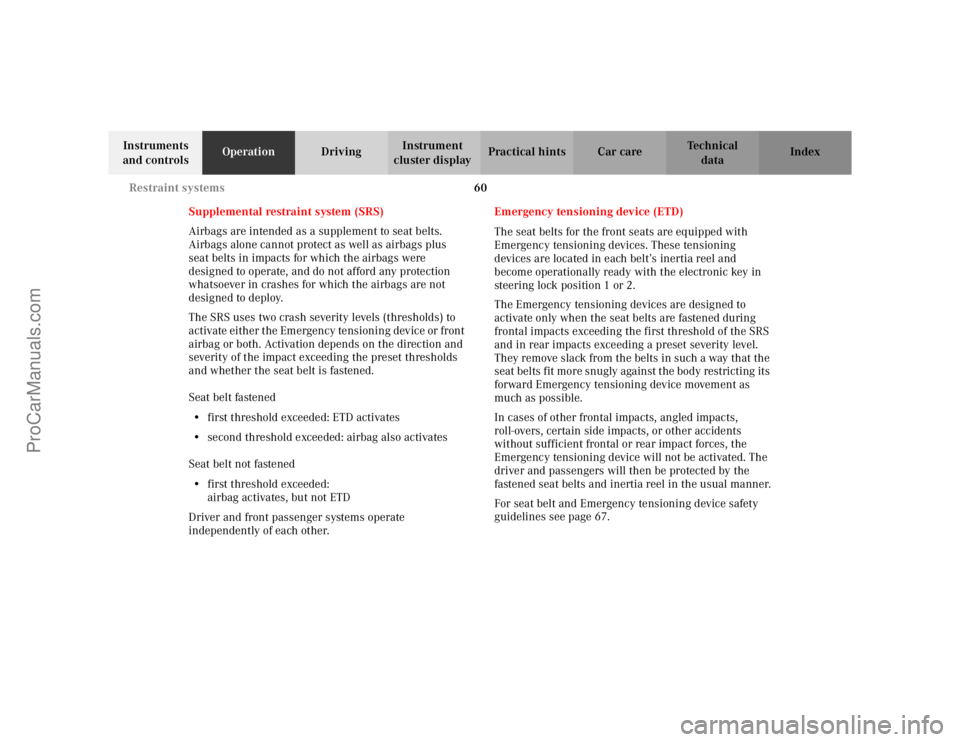
60 Restraint systems
Te ch n i c a l
data Instruments
and controlsOperationDrivingInstrument
cluster displayPractical hints Car care Index
Supplemental restraint system (SRS)
Airbags are intended as a supplement to seat belts.
Airbags alone cannot protect as well as airbags plus
seat belts in impacts for which the airbags were
designed to operate, and do not afford any protection
whatsoever in crashes for which the airbags are not
designed to deploy.
The SRS uses two crash severity levels (thresholds) to
activate either the Emergency tensioning device or front
airbag or both. Activation depends on the direction and
severity of the impact exceeding the preset thresholds
and whether the seat belt is fastened.
Seat belt fastened
•first threshold exceeded: ETD activates
•second threshold exceeded: airbag also activates
Seat belt not fastened
•first threshold exceeded:
airbag activates, but not ETD
Driver and front passenger systems operate
independently of each other.Emergency tensioning device (ETD)
The seat belts for the front seats are equipped with
Emergency tensioning devices. These tensioning
devices are located in each belt’s inertia reel and
become operationally ready with the electronic key in
steering lock position 1 or 2.
The Emergency tensioning devices are designed to
activate only when the seat belts are fastened during
frontal impacts exceeding the first threshold of the SRS
and in rear impacts exceeding a preset severity level.
They remove slack from the belts in such a way that the
seat belts fit more snugly against the body restricting its
forward Emergency tensioning device movement as
much as possible.
In cases of other frontal impacts, angled impacts,
roll-overs, certain side impacts, or other accidents
without sufficient frontal or rear impact forces, the
Emergency tensioning device will not be activated. The
driver and passengers will then be protected by the
fastened seat belts and inertia reel in the usual manner.
For seat belt and Emergency tensioning device safety
guidelines see page 67.
ProCarManuals.com
Page 73 of 341
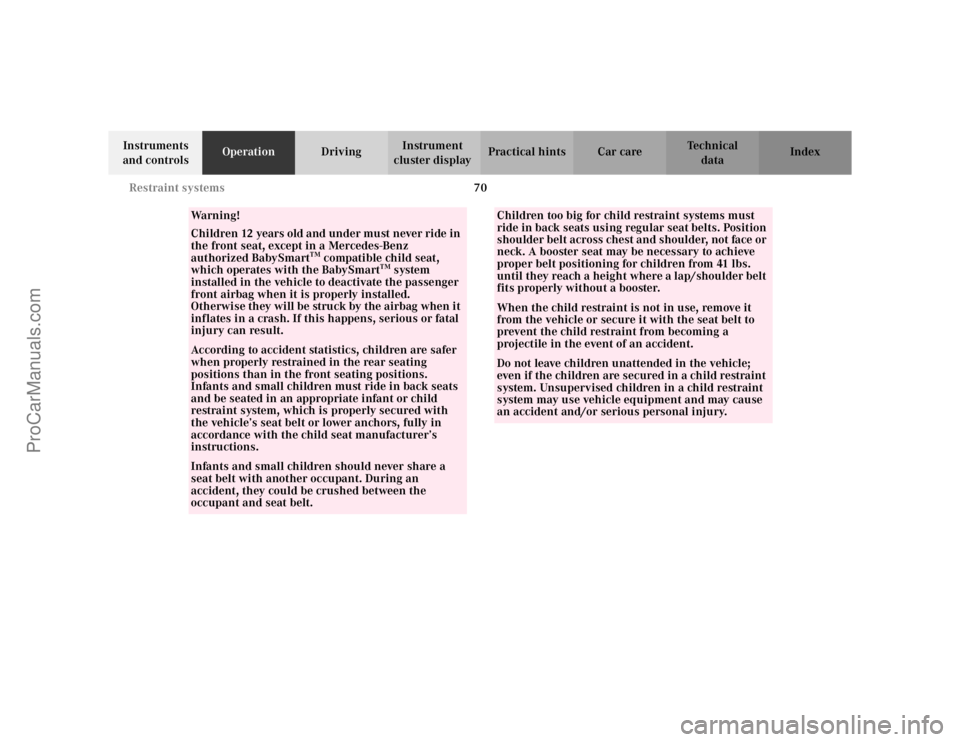
70 Restraint systems
Te ch n i c a l
data Instruments
and controlsOperationDrivingInstrument
cluster displayPractical hints Car care Index
Wa r n i n g !
Children 12 years old and under must never ride in
the front seat, except in a Mercedes-Benz
authorized BabySmart
TM compatible child seat,
which operates with the BabySmart
TM system
installed in the vehicle to deactivate the passenger
front airbag when it is properly installed.
Otherwise they will be struck by the airbag when it
inflates in a crash. If this happens, serious or fatal
injury can result.
According to accident statistics, children are safer
when properly restrained in the rear seating
positions than in the front seating positions.
Infants and small children must ride in back seats
and be seated in an appropriate infant or child
restraint system, which is properly secured with
the vehicle’s seat belt or lower anchors, fully in
accordance with the child seat manufacturer’s
instructions.Infants and small children should never share a
seat belt with another occupant. During an
accident, they could be crushed between the
occupant and seat belt.
Children too big for child restraint systems must
ride in back seats using regular seat belts. Position
shoulder belt across chest and shoulder, not face or
neck. A booster seat may be necessary to achieve
proper belt positioning for children from 41 lbs.
until they reach a height where a lap/shoulder belt
fits properly without a booster.When the child restraint is not in use, remove it
from the vehicle or secure it with the seat belt to
prevent the child restraint from becoming a
projectile in the event of an accident.Do not leave children unattended in the vehicle;
even if the children are secured in a child restraint
system. Unsupervised children in a child restraint
system may use vehicle equipment and may cause
an accident and/or serious personal injury.
ProCarManuals.com
Page 74 of 341
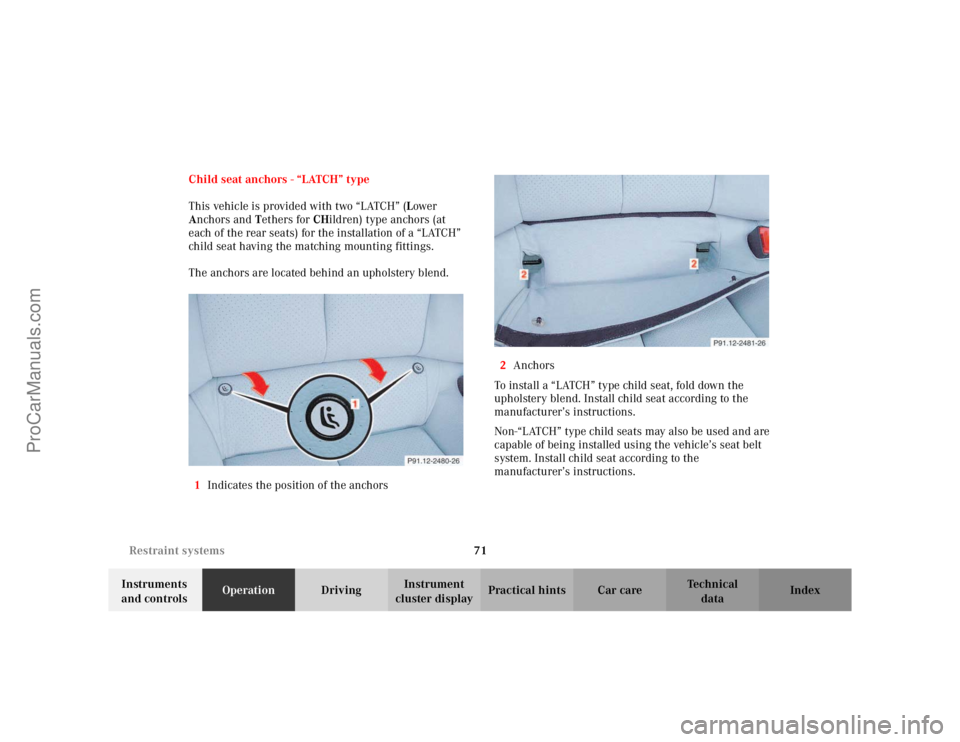
71 Restraint systems
Te ch n i c a l
data Instruments
and controlsOperationDrivingInstrument
cluster displayPractical hints Car care Index Child seat anchors - “LATCH” type
This vehicle is provided with two “LATCH” (Lower
Anchors and Tethers for CHildren) type anchors (at
each of the rear seats) for the installation of a “LATCH”
child seat having the matching mounting fittings.
The anchors are located behind an upholstery blend.
1Indicates the position of the anchors2Anchors
To install a “LATCH” type child seat, fold down the
upholstery blend. Install child seat according to the
manufacturer’s instructions.
Non-“LATCH” type child seats may also be used and are
capable of being installed using the vehicle’s seat belt
system. Install child seat according to the
manufacturer’s instructions.
ProCarManuals.com
Page 75 of 341
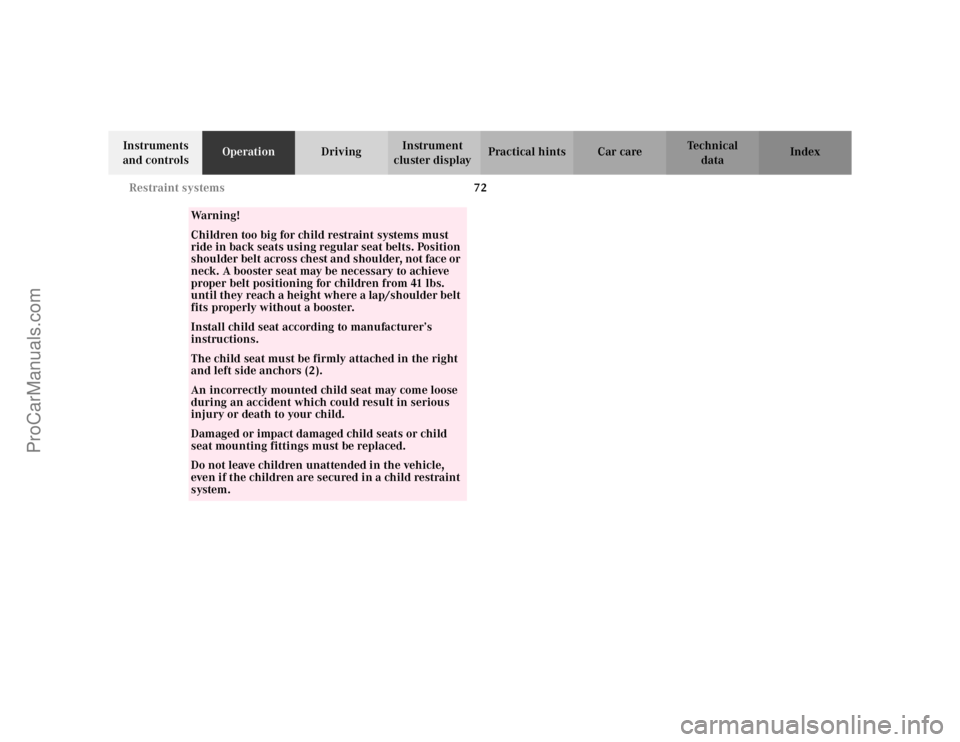
72 Restraint systems
Te ch n i c a l
data Instruments
and controlsOperationDrivingInstrument
cluster displayPractical hints Car care Index
Wa r n i n g !Children too big for child restraint systems must
ride in back seats using regular seat belts. Position
shoulder belt across chest and shoulder, not face or
neck. A booster seat may be necessary to achieve
proper belt positioning for children from 41 lbs.
until they reach a height where a lap/shoulder belt
fits properly without a booster.Install child seat according to manufacturer’s
instructions.The child seat must be firmly attached in the right
and left side anchors (2).An incorrectly mounted child seat may come loose
during an accident which could result in serious
injury or death to your child.Damaged or impact damaged child seats or child
seat mounting fittings must be replaced.Do not leave children unattended in the vehicle,
even if the children are secured in a child restraint
system.
ProCarManuals.com
Page 171 of 341
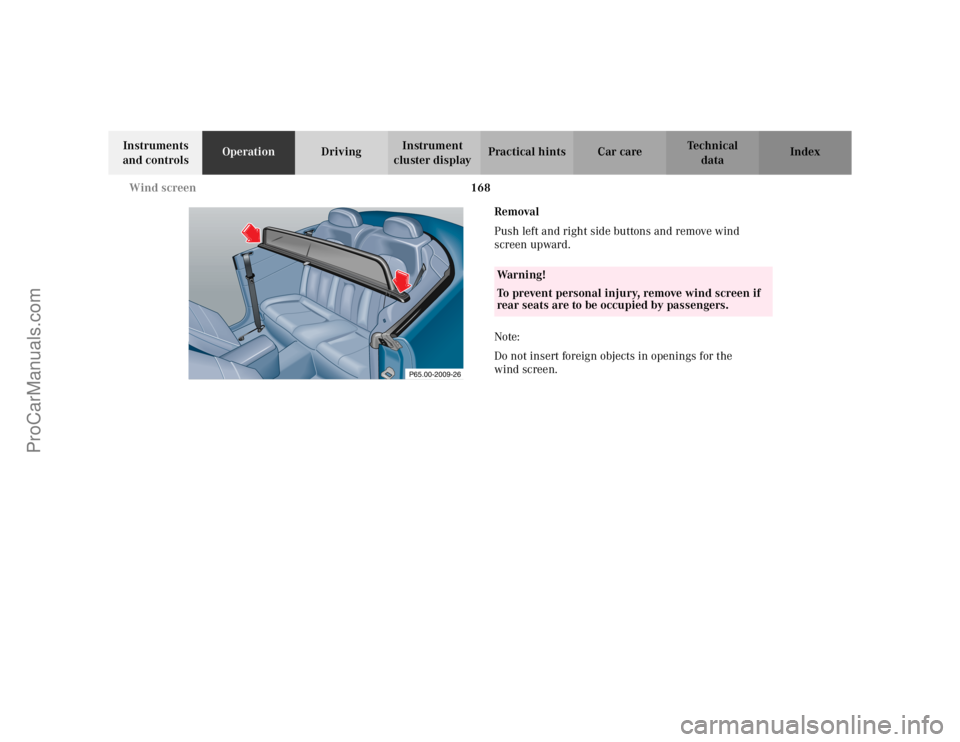
168 Wind screen
Te ch n i c a l
data Instruments
and controlsOperationDrivingInstrument
cluster displayPractical hints Car care Index
Removal
Push left and right side buttons and remove wind
screen upward.
Note:
Do not insert foreign objects in openings for the
wind screen.
P65.00-2009-26
Wa r n i n g !
To prevent personal injury, remove wind screen if
rear seats are to be occupied by passengers.
ProCarManuals.com
Page 192 of 341

189 Steering lock
Te ch n i c a l
data Instruments
and controlsOperationDrivingInstrument
cluster displayPractical hints Car care Index Important!
If the electronic key is left in the steering lock position 0
for an extended period of time, it can no longer be
turned in the lock. In this case, remove electronic key
from steering lock and reinsert.
Caution!
To prevent accelerated battery discharge and a possible
dead battery, always remove the electronic key from the
steering lock. Do not leave the electronic key in steering
lock position 0.Notes:
A warning sounds when the driver’s door is opened
while the electronic key is in steering lock position 1
or 0.
If the electronic key cannot be turned in the steering
lock, the vehicle battery may not be sufficiently charged.
See battery on page 270 or jump starting on page 271.
With the engine at idle speed, the charging rate of the
alternator (output) is limited.
It is therefore recommended that you turn off
unnecessary electrical consumers while driving in stop-
and-go traf fic. This precaution helps to avoid draining of
the battery.
Unnecessary strain on the battery and charging system
may be minimized by turning off the following power
consumers, for example: Heated seats, rear window
defroster. In addition, the automatic climate air volume
control should be set to the lowest position.
The steering lock can only be unlocked with the vehicle
battery properly charged and connected.
ProCarManuals.com
Page 232 of 341
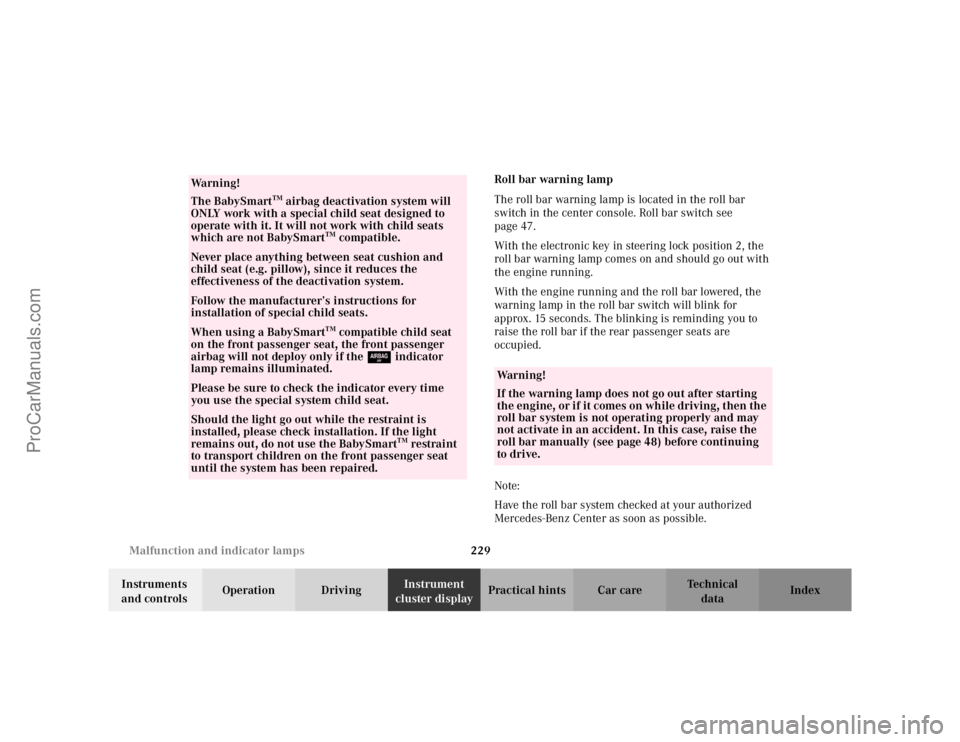
229 Malfunction and indicator lamps
Te ch n i c a l
data Instruments
and controlsOperation DrivingInstrument
cluster displayPractical hints Car care IndexRoll bar warning lamp
The roll bar warning lamp is located in the roll bar
switch in the center console. Roll bar switch see
page 47.
With the electronic key in steering lock position 2, the
roll bar warning lamp comes on and should go out with
the engine running.
With the engine running and the roll bar lowered, the
warning lamp in the roll bar switch will blink for
approx. 15 seconds. The blinking is reminding you to
raise the roll bar if the rear passenger seats are
occupied.
Note:
Have the roll bar system checked at your authorized
Mercedes-Benz Center as soon as possible.
Wa r n i n g !
The BabySmart
TM airbag deactivation system will
ONLY work with a special child seat designed to
operate with it. It will not work with child seats
which are not BabySmart
TM compatible.
Never place anything between seat cushion and
child seat (e.g. pillow), since it reduces the
effectiveness of the deactivation system.Follow the manufacturer’s instructions for
installation of special child seats.When using a BabySmart
TM compatible child seat
on the front passenger seat, the front passenger
airbag will not deploy only if the 7 indicator
lamp remains illuminated.
Please be sure to check the indicator every time
you use the special system child seat.Should the light go out while the restraint is
installed, please check installation. If the light
remains out, do not use the BabySmart
TM restraint
to transport children on the front passenger seat
until the system has been repaired.
Wa r n i n g !
If the warning lamp does not go out after starting
the engine, or if it comes on while driving, then the
roll bar system is not operating properly and may
not activate in an accident. In this case, raise the
roll bar manually (see page 48) before continuing
to drive.
ProCarManuals.com